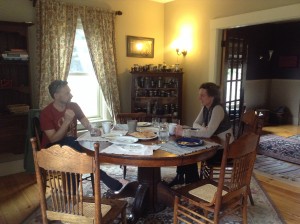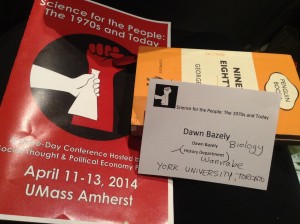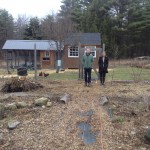 Visiting central Massachusetts is always fun. There are loads of higher education institutions, such Harvard Forest (Harvard University), where I spent 6 months during my last sabbatical, University of Massachusetts Amherst campus, Smith College, Amherst College, Mount Holyoke College, and Hampshire College, all located near each other, with lots of interactions and collaborations. Last weekend, I attended the really interesting Science for the People conference, which I tweeted about using #sftp14.
Visiting central Massachusetts is always fun. There are loads of higher education institutions, such Harvard Forest (Harvard University), where I spent 6 months during my last sabbatical, University of Massachusetts Amherst campus, Smith College, Amherst College, Mount Holyoke College, and Hampshire College, all located near each other, with lots of interactions and collaborations. Last weekend, I attended the really interesting Science for the People conference, which I tweeted about using #sftp14.

 The conference was great, but this blog is about a conversation that I had with my colleague, Prof. Kristina Stinson (above right), an ecologist at U Mass Amherst. The York University delegation stayed with Kristina, at her lovely old farmhouse in the country, surrounded by forest, and chickens. While the New England countryside is beautiful, there are some downsides, such as deer ticks that carry Borrelia burgdorferi, the spirochaete bacterium that causes Lyme Disease.
The conference was great, but this blog is about a conversation that I had with my colleague, Prof. Kristina Stinson (above right), an ecologist at U Mass Amherst. The York University delegation stayed with Kristina, at her lovely old farmhouse in the country, surrounded by forest, and chickens. While the New England countryside is beautiful, there are some downsides, such as deer ticks that carry Borrelia burgdorferi, the spirochaete bacterium that causes Lyme Disease.

 Many people living in the Pioneer Valley, as this part of the Connecticut River Valley (below left) is known, are very interested in sustainability issues: there are lots of Community Supported Agriculture (CSA) farms, a big interest in local food, and lots of people engaged in "homesteading" which involves having smallholdings, where food is grown and chickens are usually involved. My colleague, York University Faculty of Education professor, Steve Alsop (above left), was hugely entertained by the free-range chickens. While chatting with Kristina about the hens (and roosters), she commented, that since getting them, the number of insects and ticks in the lawns and garden around the house seemed to have declined drastically. This was a qualitative observation. We discussed the likelihood that her free ranging chickens, which spend their days pecking around the garden, may be having a significant effect on the populations of larvae and nymphs - earlier life stages of biting insects and ticks.
Many people living in the Pioneer Valley, as this part of the Connecticut River Valley (below left) is known, are very interested in sustainability issues: there are lots of Community Supported Agriculture (CSA) farms, a big interest in local food, and lots of people engaged in "homesteading" which involves having smallholdings, where food is grown and chickens are usually involved. My colleague, York University Faculty of Education professor, Steve Alsop (above left), was hugely entertained by the free-range chickens. While chatting with Kristina about the hens (and roosters), she commented, that since getting them, the number of insects and ticks in the lawns and garden around the house seemed to have declined drastically. This was a qualitative observation. We discussed the likelihood that her free ranging chickens, which spend their days pecking around the garden, may be having a significant effect on the populations of larvae and nymphs - earlier life stages of biting insects and ticks.
Naturally, since we're ecologists, we immediately moved onto a conversation about whether this observation has been made by other neighbours and, whether there may be research on the topic.
I've always been interested in urban chickens and have followed the Canadian debate: it's legal to keep them in Vancouver, but not in many other cities, though there's apparently something of a local urban underground chicken-keeping culture across Canada. Last summer (2013), CBC radio did a call-in programme about keeping backyard chickens in cities, from which I learned that one of the reasons for not allowing them in the city, are potential negative health impacts and increased habitat for urban vermin such as rats. And this brings me back to my conversation with Kristina. We wondered alound whether the impact of chickens on bugs may actually be a benefit for urban chick keepers. Perhaps, we speculated, chickens in urban gardens might eat termites and fire ants and have a significant impact on their populations? If this were to be the case, as demonstrated by peer-reviewed ecological research, then this might potentially have some influence on policy.
When I got back to Toronto, I did a quick check of the literature and, there's not much published on this topic. Clark and Gage (1996) examined this question in their paper, Effects of free-range chickens and geese on insect pests and weeds in an agroecosystem, in the American Journal of Alternative Agriculture (11:39-47). There were some benefits of chickens, but the effects were not significant. There's not much else that a cursory trawl through the literature turned up, though there is a nice 2009 blog by Evelyn Hansen, making the same observation as Kristina.
So, there you have it: a conversation about an observation, that led to an ecological question, and a discussion about an idea for some research into the possibility that free-range hens can affect local population densities of insect pests, and, indirectly, the diseases that they carry, in urban and rural areas. This is both a pure and applied ecological question about food webs and predator impacts that is certainly worth checking into. It's probably quite complex, but, who knows, perhaps Kristina's students might follow this up in the future.
This is how science happens...
Dawn Bazely

